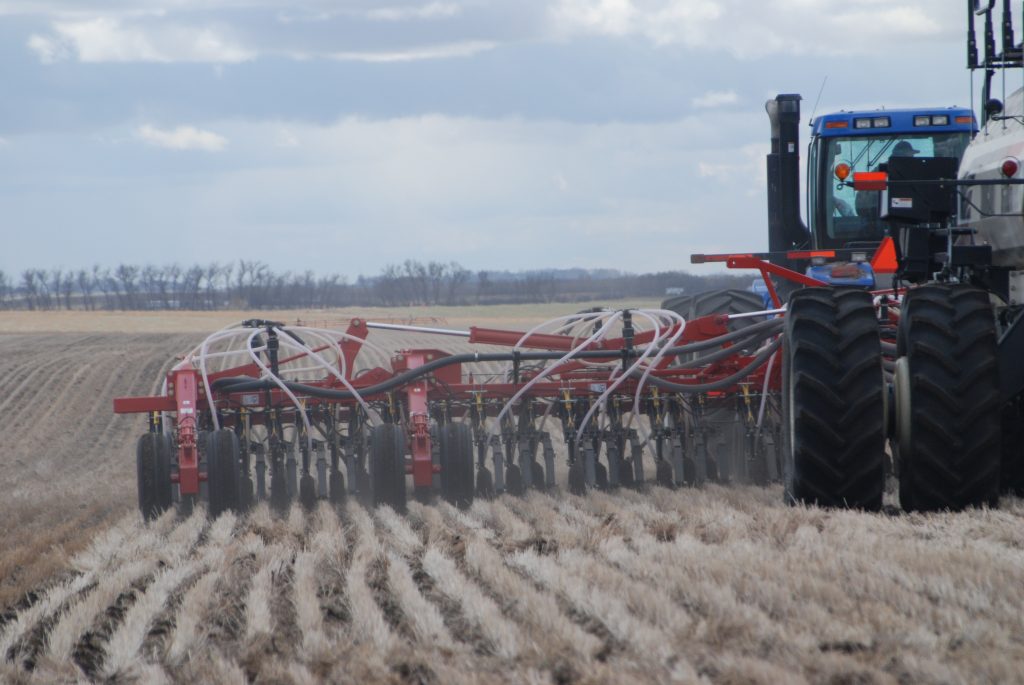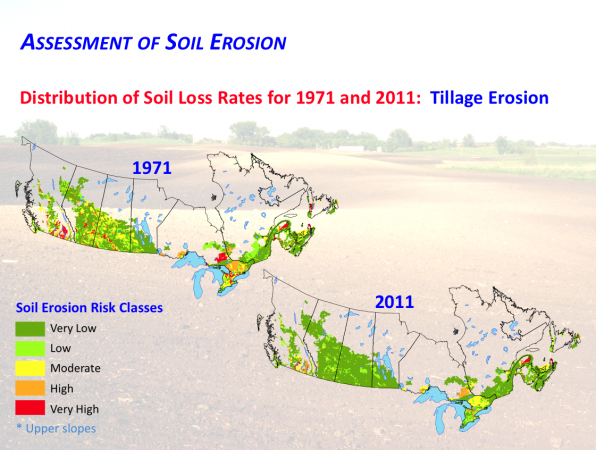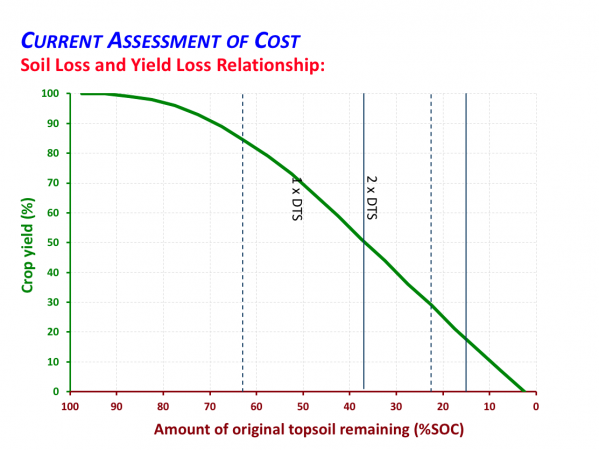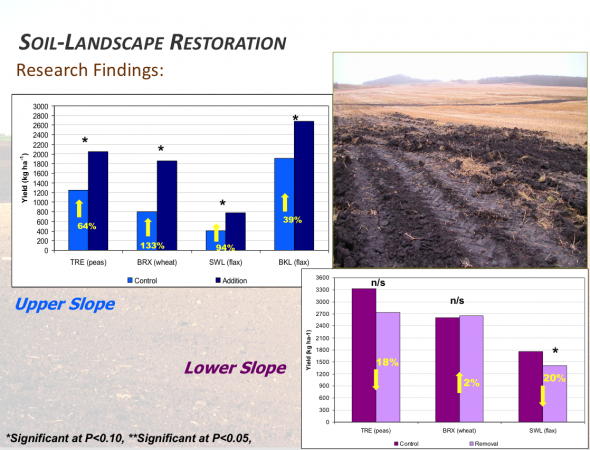
Features
Soil Summit 2019
Soil
Make soil great again: Canadian soil in transition
Actions can be taken to regain and maintain the greatness of Canadian soil.
June 14, 2019 By Presented by David Lobb, University of Manitoba, at the Soil Management and Sustainability Summit, Feb. 26, 2019, Saskatoon.
 The risk of water erosion has been reduced across Canada as conservation tillage practices have grown in popularity. Photo by Bruce Barker.
The risk of water erosion has been reduced across Canada as conservation tillage practices have grown in popularity. Photo by Bruce Barker. I have five points to make about the slogan, ‘Make Soil Great Again.’
First, soil should be considered great. The soil is a thin layer of unconsolidated material at the surface capable of supporting plant life. That’s a standard definition. Soil supports a multi-billion dollar agriculture industry in Canada and, as such, it’s a precious resource for agriculture in this country. Soil is also a limited, non-renewal resource that must be well managed to ensure it’s continued use for many generations.
Second, soil was great in the past. Prior to clearing the forests and breaking the prairie for crop production, each soil would have been in a state that we would consider to be great. That was before Europeans moved here. There are many different soils found across the country, and they would have varied greatly in all their properties reflecting their unique environments. There is tremendous variability in soil, and their ability to support a healthy ecosystem would have been optimized for their respective environments.
Soil has lost its greatness
Crop production over the last 100 to 200 years in Canada has resulted in significant degradation of soil. There are two notable periods in which weather extremes and intensification of cultivation have caused severe soil erosion. The first, the Dust Bowl, or “Dirty Thirties” in which a combination of the success of dry years and intensive cultivation of crops resulted in severe wind erosion. The second was the intensification of crop production in the 60s and 70s, which resulted in severe wind, water, and tillage erosion.
By the early 1980s, there were great concerns raised about the costs of soil degradation in Canada. There are two reports of note. Anyone who has been in soil conservation for a few years has probably seen or heard of the Senate of Canada Standing Committee on Agriculture’s 1984 report Soil at Risk: Canada’s Eroding Future.
The second one is the Science Council of Canada’s 1986 report, A Growing Concern: Soil Degradation in Canada. In this report, there is data from Dr. Don Rennie, who estimated the annual cost of soil erosion to be about half a billion dollars a year. In 2016 dollars, it’s roughly double that, about a billion dollars a year. These values were alarming at the time and, certainly, that alarm was a major impetus for the development and enhancement of soil conservation technologies and practices that are very common place in the prairies now, and for increased awareness and adoption of soil conservation technologies and practices throughout the agriculture industry across the country. In particular, conservation tillage practices were promoted and conservation tillage was widely adopted. Back in the 1970s, there probably was what we would consider zero per cent of conservation tillage, or no-till or zero till. Now, in some areas, like Saskatchewan, it’s well over 80 per cent.
A lot has changed since the 1980s. With respect to public awareness to government support through policies, programs and research, and to industry action, there has been steady decline in interest in soil conservation. There’s a pervasive belief amongst all the stakeholders that we know all there is to know about soil erosion and soil conservation, and that the job is done, and we need to move on. A sense of fatigue has set in, and it’s fairly common throughout the country.
After almost 40 years, I believe there’s a need to revisit the economic figures generated by Dr. Rennie, and to improve upon them and update them to assess the status of our soil resources and our progress in conserving soil. A lot has changed since then. There’s a lot of scientific development, better computing, and better databases for our soils information, and there’s a lot that we can improve upon.
A couple of years ago, I initiated a study at the request of the Soil Council of Canada and, with the collaboration of Agriculture and Agri-Food Canada. The focus of this assessment was simply the direct impacts of soil loss on crop productivity and the market values over a long history of crop production. It does not capture the indirect impacts of the inefficiencies and input use associated with erosion or the purchase of equipment. It doesn’t consider the offsite impacts either and the things that do get the public concerned. Siltation of ditches is an example, or harbours, and things that cost municipalities and governments lots of money. The indirect costs are considered in most studies to be equal to, if not much greater than, the cost of crop production.
Our assessment was built on the ongoing work of Agriculture and Agri-Food Canada, and it’s Agri-Environmental Indicators, which began about 1993. They have continued under a number of programs, such as the Agri-Environmental Indicators Project, then the National Agri-Environmental Health Analysis and Reporting Program and, most recently, the Sustainability Metrics Program. These findings have been reported by the Government of Canada in 2000, 2005, 2010, 2016, and the most recent analysis is ongoing now.
There are different types of analysis and methodology we use for assessing soil erosion. For each soil map unit across the country, we have varieties of landform types, and for each landform type we can characterize it in terms of the slope gradients and the slope length of each one of the segments of each landform. We also have soils information that overlays on top of that landform information, and then we use information from the census looking at tillage systems and cropping systems across the country on each one of those map units. With climate data, we can come up with some fairly detailed and fairly accurate analysis of environmental indicators, in this case, soil erosion.
We have a few models we use to assess soil erosion. There are wind and water erosion risk indicators, which are based on fairly common erosion models. There is also a tillage erosion model, which I developed, and then there’s one that rolls all of those processes up into one number, and that’s the soil erosion risk indicator.
There are different erosion classes ranging from extremely low/negligible to moderate to very high erosion that is not sustainable. The ones that are of concern, particularly for this analysis looking at crop production and crop yield loss, are the moderate to severe classes.
When we look at the results for water erosion in 1971 and 2011, water erosion doesn’t really show up at a mapping scale in the prairies but it certainly does in Eastern Canada. There’s been a dramatic reduction in the water erosion risk across, particularly, Eastern Canada as we have adopted conservation tillage practices.
If you look at wind erosion, there’s no wind erosion risk in Eastern Canada, but there certainly is in Western Canada. If you look back at 1971, there are certainly areas where you have significant levels of wind erosion and, in some cases, moderate to severe levels of wind erosion.
If you look at tillage erosion, because tillage isn’t based on climate, and it’s based simply on how much tillage you do, across the country it was a problem back in the 70s, and continues to be a moderate to severe problem in certain areas and certain crop production systems across the country. Again, with the reduction of tillage over the 70s, 80s and 90s, and with the reduction of summer fallow in particular, the risk of tillage erosion has dramatically reduced, as well.
When you add wind, water and tillage erosion together, while there has been a significant improvement between 1971 and 2011, there are significant concerns in many parts of the country.
If you look at the national data, about 37 per cent of the land and crop production in Canada in 1971 was either moderately to severely eroded each year, but by the time you get to 2011, that’s dropped to just under 10 per cent. That is a dramatic improvement in the levels of soil erosion that’s occurring on our cropland. I will point out that in Saskatchewan, it dropped down to about 1.2 per cent by our estimates, so there’s very little land, at this point, which is now experiencing moderate to severe levels of soil erosion in this province.
The key thing though is relating that soil loss to crop yield. If you lose a little bit of organic carbon and a little bit of top soil, crop yield isn’t significantly impacted, but there does become a point where you’ve lost so much soil organic matter, that the crop yields start to drop, and start to drop dramatically. That non-linear relationship becomes quite critical in understanding the economic behaviour of crop production to soil loss.
The crop yield loss on high eroding cropland back in 1971 may have been about 17 per cent, but after an additional 30 years or 40 years of erosion, you’re now losing 60 per cent of your crop yield. But comparing 1971 with 37 per cent of the land with 17 per cent crop yield loss to 2011 with only 9.5 per cent of the area but 60 per cent crop yield loss on average, you really haven’t improved the situation much in terms of overall crop production.
That shows up in the economic analysis. For 1971, the market value of that yield loss was about $1 billion. But if you look forward it’s now up to $3 billion a year in 2011 even though the amount of high-eroding soil had dropped to 9.5 per cent of cropland. We also tracked the cumulative economic loss between 1971 and 2011 and it was about $40 to $60 billion of loss.
The costs have gone up for a variety of reasons and, although soil conservation efforts have reduced the amount of cropland that is moderately to severely eroded, still more needs to be done if you’re worried about growing profitable crops in Canada.
Regain the greatness of soil
We need to think more broadly about what tillage is and what conservation tillage is. When you think about tillage erosion, as well as wind and water erosion, you have to keep in mind that there are some practices that leave more crop residue, which makes them effective at combating wind and water erosion. Tillage erosion, in many cases, is more of a problem than wind and water erosion.
When you start thinking about moving soil, there is a trend for higher speed equipment, and that means you’re throwing more soil further, and probably with greater variability, and I’m thinking of vertical tillage, in particular. Those practices are, probably, much more erosive than a mouldboard plough, and should be of great concern to everyone who’s interested in soil conservation.
We did an experiment in Manitoba and Saskatchewan where I looked at how much soil is moved by seeding operations. High disturbance seeders don’t move much soil, but they move with a tremendous amount of variability and they can be as erosive as a mouldboard plough. Also, when we’re looking at conservation tillage, remember that it simply reduces the amount of soil erosion and the loss of soil organic carbon.
Conservation tillage, again, is that first step. We need to focus on the second step with things like growing perennial crops or adding manure. There are some farmers that would put all of their manure on those eroded hilltops. And you can even more creative than that.
There is a practice that I’m going to spend a couple of minutes on: soil landscape restoration. A typical soil in the hilly lands of the prairie today has thin topsoil on the hilltops and thicker slopes where top soil has been moved by tillage to the bottom of the slope.
When I started to get in this business in the 1990s, it would not be surprising to see one or two feet of topsoil lost on the hilltops, and about the same amount of accumulation at the bottom of the slopes. Because it’s caused by tillage erosion, we have the opportunity were you can take that topsoil and put it back on the eroded hilltops. That’s the practice of landscape restoration.
We did a small study in Manitoba with four sites where we moved soil from the bottom of slopes back onto the hilltops. We scraped about 10 centimeters of soil from the bottom of the slope, applied it to the hilltops. The yields on the hilltops bounced up quite dramatically, and it didn’t create any significant yield losses on the bottom of the slope from removing soil. In the wet years, we saw about a 10 to 33 per cent yield increase on those hilltops, and about a 40 to 130 per cent yield increase in dry years.
There’s a net improvement of crop yield throughout the landscape, so much so that if you looked at the economic improvement of the whole landscape, that practice was paid for within about three to five years. The return on investment was very rapid from a land improvement standpoint. So, it’s quite a significant change in how we could deal with those eroded landscapes in this region.
There is a need for or desire to have great soil
I believe there is a desire to have great soil. There’s certainly a need to produce food in Canada, and to do so sustainably and competitively. If we want to do that, and to succeed in this endeavour, we must ensure healthy soil resource and we must protect those healthy soils, and we certainly must look at the degraded soils and restore those degraded soils somehow.
There is a cost of doing nothing. The increase in variability in climate and the increase in severity and frequency of weather extremes can only amplify the types of crop yield losses we are seeing on those eroded landscapes, and they threaten our profitability and food security.
The degradation of landscape has increased over time. Once the topsoil is gone on the hilltops, the productive sub-soil that’s exposed now gets dragged down slope and it degrades the ability of the whole field to produce productive and profitable crops. You start to see carbonate-rich sub-soils burying, or capping off, that nice topsoil at the bottom of the slope. We’ve seen this in Saskatchewan, Manitoba, Wisconsin, Minnesota, South Dakota, and Ontario.
Lastly, as public agencies, we must provide the means to protect and restore the soil, and we’re certainly looking at science and technology and the awareness and education policy and programs. One of the biggest threats in our ability to do what need to do with respect to soils and soil resources and our management of it is to make sure we have the ability to characterize soils and have databases that we can use to do these types of analysis — and the federal government has largely abandoned that. There has been a loss of soil surveyors. There’s almost no capacity left to characterize soil or to characterize the changes in soils that I’m taking about. It’s astounding to me. As an educator in soil science, it is very troubling that the government has just walked away from this. There is talk about doing other things federally and, hopefully, some of those move forward and make some progress in the next few years before it’s completely impossible to move back towards having a good soils database.
More from the 2019 Soil Summit
Watch David Lobb share ways farmers and agronomists can use the information presented to change their management practices in his Speaker Spotlight video. To see other presentations and speaker spotlight videos, visit our archives for the 2019 Soil Management and Sustainability Summit.


